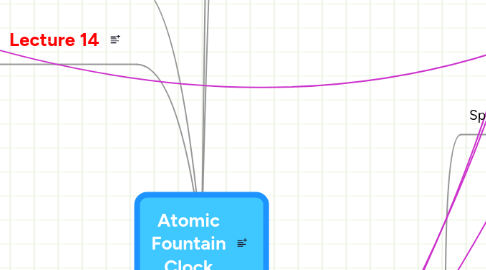
1. Lecture 15
1.1. Atomic fountain clock.
1.1.1. Moving molasses.
1.1.2. Double pass through microwave cavity.
1.1.3. Ramsay interferometry.
1.1.4. Clock uncertainty.
1.2. Future of atomic clocks.
2. Lecture 14
2.1. Magneto-optical trap (MOT).
2.1.1. Zeeman effect.
2.1.2. Total force on atoms.
3. Lecture 11
3.1. Is the ground state hyperfine transition in H suitable for an atomic clock?
3.2. Zeeman effect.
3.2.1. Is H atom clock sensitive to external magnetic fields?
3.2.2. Use DPT to calculate energies of hyperfine states as a function of magnetic field.
3.2.3. Breit-Rabi diagram of H.
3.2.4. Transition least sensitive to magnetic fields.
3.2.5. H not good as a clock for practical reasons.
3.3. Advantages to using 'one-electron' alkali atoms for clocks, e.g. Cs.
3.4. Transit time broadening.
4. Lecture 12
4.1. Lecture 13
4.1.1. Lasers.
4.1.1.1. Extended cavity diode laser.
4.1.1.2. Power requirements.
4.1.2. Laser cooling.
4.1.2.1. Doppler effect.
4.1.2.1.1. Friction like velocity dependent force.
4.1.2.1.2. Laser detuning.
4.1.2.2. Cooling rate.
4.1.2.3. Limits.
4.2. Light forces.
4.2.1. Momentum transfer.
4.2.2. Balance of absorption and stimulated emission.
4.2.3. Maximum light force.
4.2.3.1. Maximum light acceleration.
4.2.3.2. Atom beam stopping distance.
4.2.3.3. Can a lamp be used as the photon source to stop an atom beam?
5. Lecture 3
5.1. Visualising electron distributions during transitions.
5.1.1. Time-dependence evolution of relative phase.
5.1.1.1. Absorption/emission of photon.
5.1.1.2. 2p0<->1s0 See movie 2p0to1s0.avi
5.1.1.2.1. Linear polarisation.
5.1.1.3. 2p1<->1s0 See movie 2p1to1s0.avi
5.1.1.3.1. Left circular polarisation.
5.1.1.4. 2p1<->1s0 See movie 2p1to1s0(2).avi
5.1.1.4.1. Horizontal linear polarisation.
5.1.1.5. 2p-1<->1s0
5.1.1.5.1. Right circular polarisation.
5.1.2. Dirac notation.
6. Lecture 1
6.1. How good is a clock?
6.1.1. Clock uncertainty.
6.1.2. Definition of the SI second.
6.2. Principle of atomic clock.
6.2.1. Atomic transition provides reference frequency.
6.2.2. Advantages.
6.2.3. Interaction of atom with EM field.
6.2.4. Minimise broadening mechanisms.
6.3. Brief history of atomic clocks
6.3.1. Atomic beam clocks.
6.3.2. Improved uncertainty.
6.3.3. Miniaturisation and commercialisation.
6.3.4. Fountain clock.
6.4. How do atoms interact with EM fields?
6.4.1. Classical picture.
6.4.1.1. Electric dipole interaction.
6.4.1.2. Magnetic dipole interaction.
6.5. Lecture 2
6.5.1. Electric dipole interactions.
6.5.1.1. Electric dipole moment.
6.5.1.2. Electric dipole approximation.
6.5.1.3. Does an atomic orbital have a dipole moment?
6.5.1.3.1. Expectation value of dipole moment operator.
6.5.1.4. Does a superposition of eigenstates have a dipole moment?
6.5.1.4.1. Electric dipole moment associated with transitions between eigenstates.
6.5.1.4.2. Opposite parity. Electric dipole allowed transition.
6.5.2. Magnetic dipole interactions.
6.5.3. Which is stronger, electric or magnetic dipole interactions?
6.5.4. What happens to an atom undergoing a transition?
6.5.4.1. Visualising electron distributions in 3D.
6.5.4.1.1. Hydrogen atom orbitals.
7. Lecture 4
7.1. Spontaneous emission.
7.1.1. Explicitly forbidden by quantum mechanics.
7.1.1.1. Vacuum fluctuations.
7.1.2. Rate of decay. Einstein A-coefficient and lifetime.
7.1.3. Natural linewidth.
7.1.4. Is 2p<-1s in H a good clock transition?
7.2. Hyperfine transitions and spin.
7.2.1. Hyperfine splitting.
7.2.1.1. Same parity. Magnetic dipole allowed transition.
7.2.2. Einstein A-coefficient.
7.2.2.1. Is the ground state hyperfine transition in hydrogen a good clock transition?
7.2.3. What causes hyperfine splitting?
7.2.4. How large is hyperfine splitting?
7.3. Lecture 5
7.3.1. Time-independent perturbation theory (TIPT).
7.3.1.1. First-order correction to energies.
7.3.1.2. First-order correction to wavefunctions.
7.4. Lecture 6 and lecture 7
7.4.1. TIPT second-order correction to energies.
7.4.2. Time-dependent perturbation theory (TDPT).
7.4.2.1. Absorption of photon.
7.4.2.2. Stimulated emission.
7.4.2.3. Spontaneous emission.
7.5. Lecture 8 and lecture 9
7.5.1. Degenerate perturbation theory (DPT).
7.5.2. Hyperfine transitions and spin cont.
7.5.2.1. Spin-spin interactions.
7.5.2.1.1. Spin-orbit interaction
7.5.2.1.2. Nuclear spin - total angular momentum interaction.
7.5.2.1.3. 4 degenerate spin configurations in H ground state.
7.5.2.1.4. s-electron penetrates nucleus.
7.6. Lecture 10
7.6.1. Hyperfine transitions and spin cont.
7.6.1.1. Use DPT to calculate energies of 4 spin configurations in H ground state.
7.6.1.2. Lifetime of spontaneous emission from upper hyperfine state.
7.6.1.3. Hyperfine resolved energy level diagram of H ground state.
